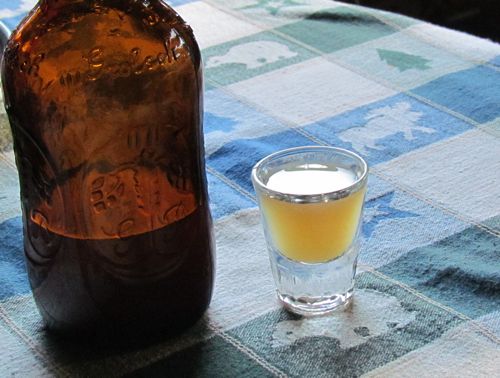My recent effort to make hard cider (see The Ghost of John Chapman) has, if you will, borne fruit. In fact, the project has provided more benefits than we’d anticipated.
I’ve spoken before about how we use the must—yeast saturated fruit mash extracted from the wine making process—as food when possible. After pressing out the young wine we often bake the must into fruit bars or muffins.
Pressing eight pounds of apples produced quite a bit of mash. As I mentioned in the first post, I’m being very casual about this cider batch, because we like unfiltered sweet cider. Still, I filtered out as much of the solids as I could after the initial ferment. I’d thought about baking it into a pie; I had at least two pies worth, probably quite a few more.
Instead, Michelle cooked it up as applesauce. She added powdered ginger to hide the residual yeast flavor. The heat cooked out most of the alcohol.
The resulting applesauce tastes excellent! We’re using it to flavor our homemade yogurt (see Homestead Yogurt). It’s good enough that we feel justified to attribute the cost of the apples to the applesauce alone, so the hard cider may be considered free drinks!
The hard cider tastes great. I consider it finished, so I set it outside for much of the day during our recent cold weather to kill the yeast. I’d rather stop the yeast naturally than use the prescribed method, dosing the batch with campden tablets.
I also set aside some of the cider to make apple jack in our below-freezing weather.
Apple jack comes from freezing the water out of hard cider until a stronger liquor distills. My source (see The Homestead Reference Library: The Alaskan Bootlegger’s Bible) recommends clarifying carefully before jacking, as the intensifying process also concentrates cloudiness. I don’t care, I’m experimenting, not seeking perfection.
This process strikes me as a bit odd. If we keep the alcohol level of the cider low, comparable to beer, it’s hard cider. If we let the yeast continue to work, we’d get wine, with a higher alcohol content. But now, we’re making apple jack by concentrating the alcohol to raise the level above wine. I guess we’re leapfrogging from hard cider to liquor. It’s a little weird, but worth a try.
The first jacking produced a wonderful brew, sweet and strong. I kept freezing the distillate until it stopped crystalizing.That happened by the next day, with our current near zero temperatures.
We just got a little apple jack—hardly more than a few tastes—but that’s all right. I also thawed the ice extracted, and bottled it as a weaker hard cider. It has a mild alcohol content, and it tastes good. It too will be free drinks.

